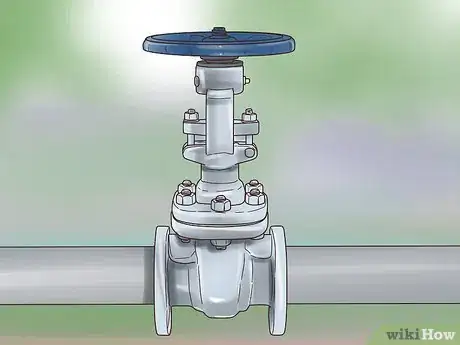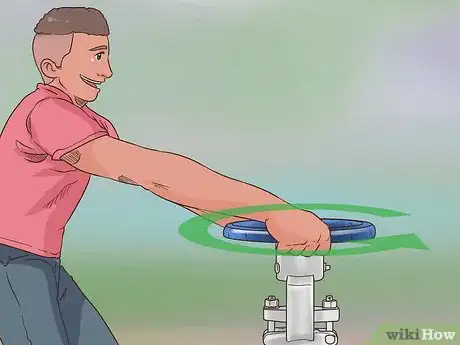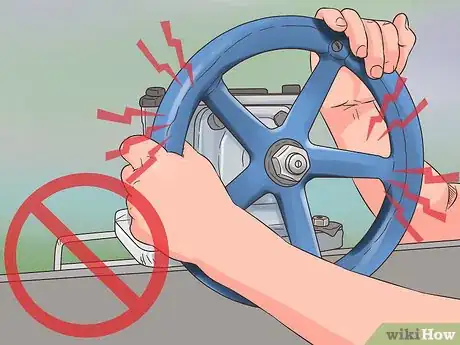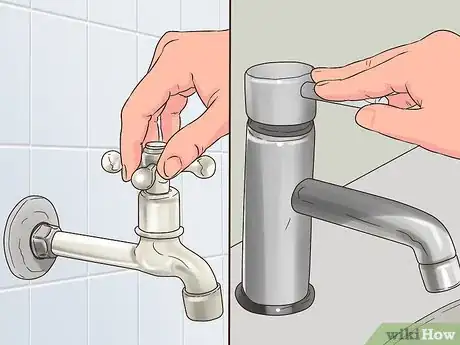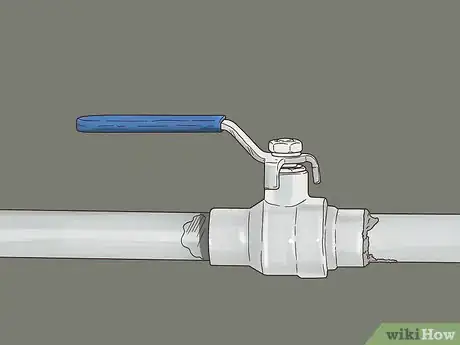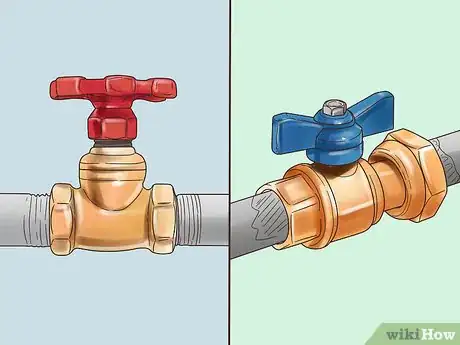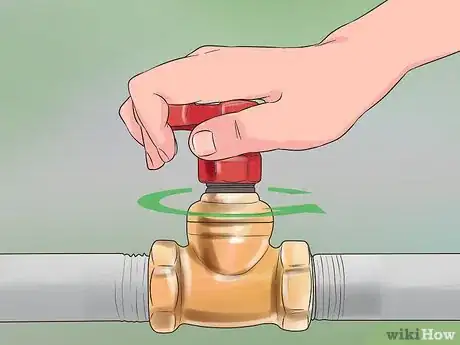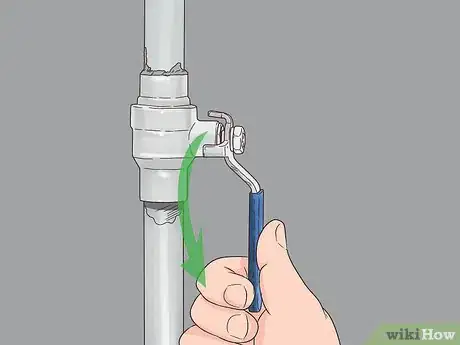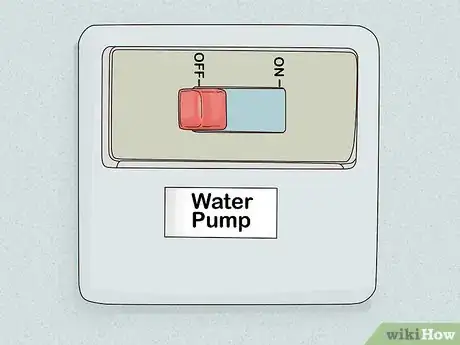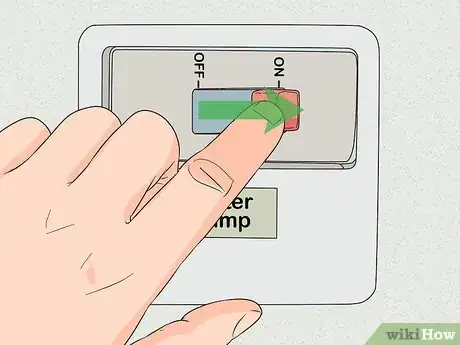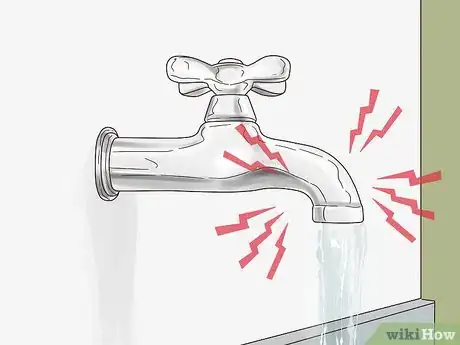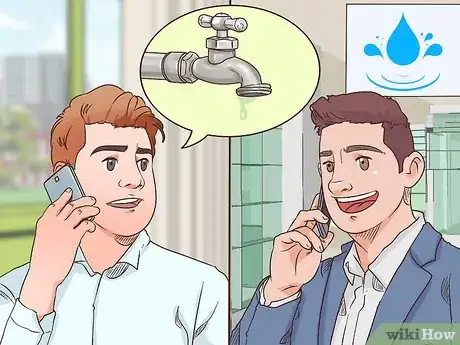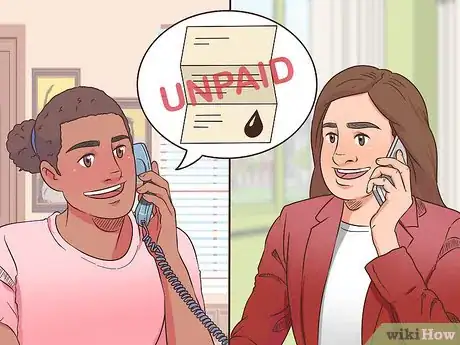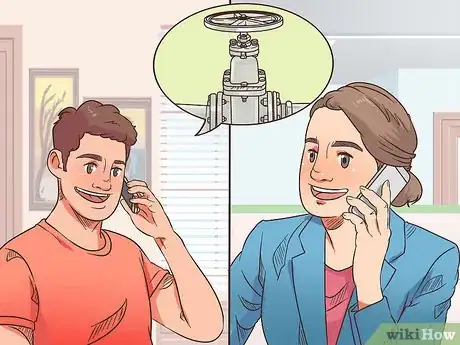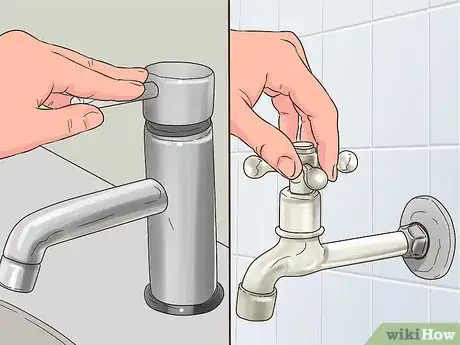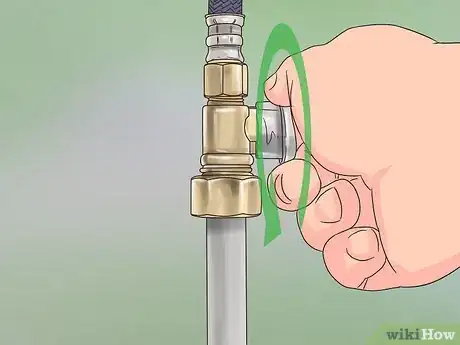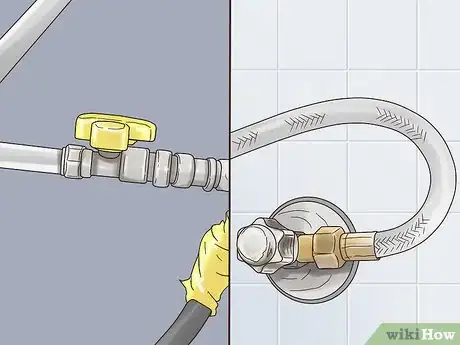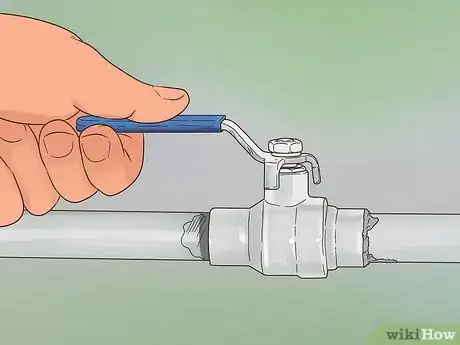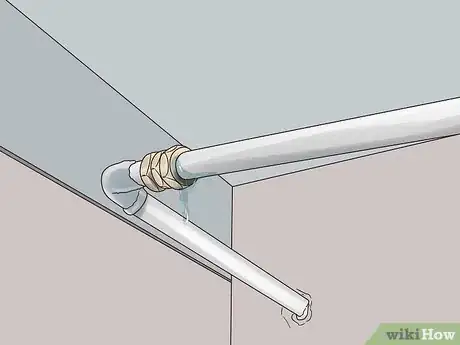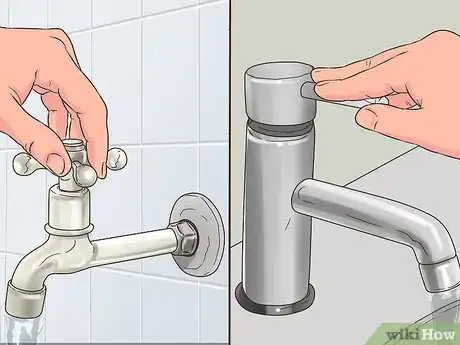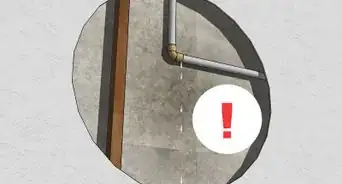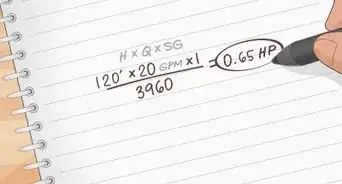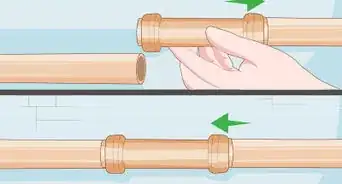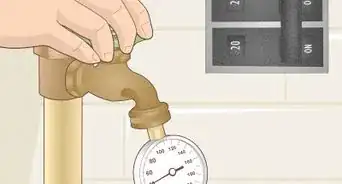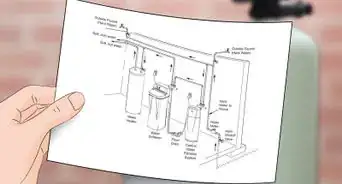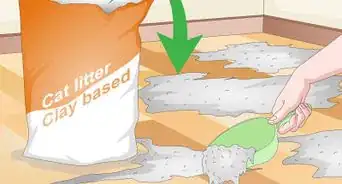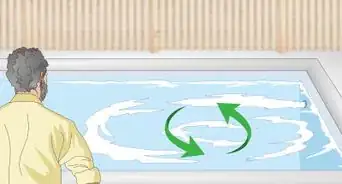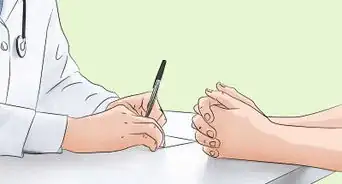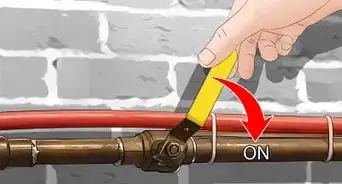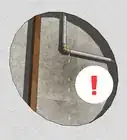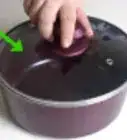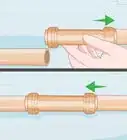This article was co-authored by Dave Jones. Dave Jones is a Professional Plumber and the Midwest Regional Vice President at Roto-Rooter Plumbing & Water Cleanup. In 1992, Jones joined Roto-Rooter as a drain service technician at the age of 18. Since then, he has risen through the ranks into positions of increasing authority. Dave served as general manager of Roto-Rooter’s Charlotte, North Carolina, and Atlanta, Georgia branches before being promoted to Contractor Area Manager and later to Regional Vice President. Dave holds Master Plumber Licenses in Pennsylvania, North Carolina, and Georgia.
There are 18 references cited in this article, which can be found at the bottom of the page.
This article has been viewed 173,191 times.
Whether your water has stopped unexpectedly or because of planned repairs, you probably need to get it back on again. In most cases, the water company can turn the water back on for you. If you want to turn the water on manually, however, you can either switch on the valves next to your appliances or use the main water shut-off valve.[1] Well water will require you to locate an electrical switch as well. If you are de-winterizing the house, you may need to check for leaks or damage first.
Steps
Turning Supply Valves On
-
1Locate the supply shut-off valve near the appliance or fixture. This valve will look like a wheel or a lever. It should be attached to the pipe running out of the device.[2] [3]
- The wheels are called gate valves while the levers are called ball valves.
- Some older houses may not have supply shut-off valves for appliances and sinks. In this case, you will need to turn on the water at the main valve.
-
2Turn the valve counterclockwise. If it is a gate valve, you may need to do 2 to 4 full turns before it turns on. If it is a ball valve, turn it so that it is parallel with the pipe.[4]
- You should be able to turn the valve with your hands, but if that is difficult, you can use a wrench to help you.
Advertisement -
3Avoid forcing the valve. If the valve won’t turn, call a plumber. Forcing the valve can cause the pipe to crack, burst, or leak. A plumber will be able to fix or replace the valve for you.[5]
Switching on the Main Valve
-
1
-
2Locate your shut-off valve.[8] In most areas, the valve is located outside. Check outside near the street. You may notice a grate in the ground. If you lift up this grate, you should see a hole with a pipe running through it.[9]
- If you live in a colder climate, the meter may be inside, either in a basement, utility closet, or near the water heater.
- To open the grate, you can simply reach down and pick it up. If this is hard to do, insert a wrench in the key hole. Turn it and lift up to remove the grate.
-
3Identify the water valve. You may notice a water meter or gauge with 1 or more turn-handles on either side. These handles are the shut-off valves.[10]
- In newer homes, there may be 2 valves, 1 on either side of the water meter. In this case, use the valve closest to your house, which will be a gate (or wheel-shaped) valve. You can turn this by hand.
- In older homes, there will be just 1 valve. It will have a notched top that is perpendicular to the pipe. You will need a water key to turn this valve. You can get one at a hardware store.[11]
-
4Turn the valve counterclockwise. Start by turning it ¼ of a rotation. Pause for 20 seconds before turning it another ¼. This will allow the water to start running without bursting your pipes. Your water should now work.[12]
- If the valve is wheel-shaped, you can turn it with your hands or with a wrench.
- If it has a notched top, use a water key by holding the T-shaped side. Place the other side on top of the notch and turn.
- If the valve won’t turn, don’t force it. Instead, call a plumber to help. Forcing the valve can cause a leak.
Turning Well Water Back On
-
1Turn the upper valve at the water pump. You may notice a pipe coming up and over the water pump. It may have a ball valve (which will look like a lever). Turn this so that it is parallel with the pipe.[13]
- If you have a wheel-shaped gate valve at the bottom of your water pump, do not turn this to the on position. Leave it closed.
-
2Locate the electrical switches. In most cases, the electrical power for the well pump will be shut off at the same time as the water itself. You may have 2 switches: one near the pump and one at the main electrical breaker. Check both to see if they have been switched off.[14]
-
3Flip the switch on. If you have 2 switches that are turned off, turn on the main electrical switch on first and then turn on the switch next to the pump. Make sure that there is no standing water under or around you. If there is, do not touch the switch. Dry or mop up the water. Your hands must be dry before touching the switch. Otherwise, you may be at risk of electrical shock.[15]
-
4Wait for the pump to fill. It will take a few minutes before you can use water. You may hear water in the pipes. As it fills, you can turn on a sink to see if it is working. The sink should sputter and spit for several minutes.[16]
- If the water doesn't start running, call a plumber.
Notifying the Water Company
-
1Contact the water company. In most cases, you should let public works or the municipal water company turn your water on for you. You can contact your local water company by calling them or using their online assistance portal.[17]
- If your water is drawn from a well, you do not need to contact the water company.
-
2Ask the water company to start service if you just moved. Contact the company 2 weeks in advance. If possible, ask them to turn the water on the day before you move in. You may need to provide basic identification and a form of payment.[18]
- Many water companies allow you to turn the water on using an online form.
-
3Explain what the problem is if your water stopped unexpectedly. If your water stopped unexpectedly, the water company may be able to tell you why.[19] Some common problems include:[20]
- Unpaid bills. You may be asked to pay your water bill and extra late fees.
- Neighborhood or city leak. You will have to wait until the leak is fixed.
- A broken valve. They may send someone to inspect your valve or suggest that you hire a plumber. If the valve is broken, the city must fix it.
-
4Request permission to turn the main valve on yourself. The main valve and water meter are the property of your city. Call the water company to get permission to touch or handle the main valve.[21] If you are not allowed to touch the main valve, they will do it for you.[22]
- You only need permission if you are turning on water for the entire house or property. Appliance supply valves can be turned on or off at your leisure.
Dewinterizing a House
-
1Turn off all faucets. If you winterized the house, you may have left all of the faucets open. Go through the building and turn all of these faucets off for any showers, sinks, or baths you have.[23]
- If you would like, you can remove the aerators from your sinks to prevent mineral build-up when the water starts.
-
2Turn on supply valves. These are the valves underneath your fixtures and water devices, including your sinks, toilets, and water heater. Turn them counterclockwise until they stop.[24]
-
3Check the pipes for visible damage. Check every pipe in the building to make sure that no breaks or cracks developed. If you notice any damage, call a plumber to have them repaired. Don’t forget to check your:[25]
- Water heater
- Sinks
- Toilets
- Showers and baths
- Refrigerator
- Washing machine
- Hoses
-
4Turn on the water at the main shut-off valve. Once you have checked everywhere for leaks, locate the shut-off valve, either outside or in your home. Turn it a quarter of the way and wait 20 seconds. Then turn it another quarter.[26]
- Water valves are usually located near the street beneath a grate. If there are 2 valves, use the one closest to your house.
- If you can't turn the valve by hand, you may need a wrench or a water key.
- Do not turn the valve on all at once. This could flood your pipes and cause a leak.
-
5Check for leaks again. Quickly go back to check all of your fixtures. Look for any water leaking from the pipes from small cracks that you may not have noticed before. If there are any leaks, call a plumber.[27]
-
6Turn on faucets one by one. Let the faucet run for about 20 seconds before turning it off. Check for leaks around the pipes again. If there are no leaks, move on to the next faucet.[28]
- If you notice a leak, call a plumber for repairs.
Expert Q&A
-
QuestionCan I turn my water back on myself?
 Dave JonesDave Jones is a Professional Plumber and the Midwest Regional Vice President at Roto-Rooter Plumbing & Water Cleanup. In 1992, Jones joined Roto-Rooter as a drain service technician at the age of 18. Since then, he has risen through the ranks into positions of increasing authority. Dave served as general manager of Roto-Rooter’s Charlotte, North Carolina, and Atlanta, Georgia branches before being promoted to Contractor Area Manager and later to Regional Vice President. Dave holds Master Plumber Licenses in Pennsylvania, North Carolina, and Georgia.
Dave JonesDave Jones is a Professional Plumber and the Midwest Regional Vice President at Roto-Rooter Plumbing & Water Cleanup. In 1992, Jones joined Roto-Rooter as a drain service technician at the age of 18. Since then, he has risen through the ranks into positions of increasing authority. Dave served as general manager of Roto-Rooter’s Charlotte, North Carolina, and Atlanta, Georgia branches before being promoted to Contractor Area Manager and later to Regional Vice President. Dave holds Master Plumber Licenses in Pennsylvania, North Carolina, and Georgia.
Master Plumber, Roto-Rooter Plumbing & Water Cleanup If you're the one who shut it off in the first place, then yes. It's possible that you can turn the water back on even if you weren't, but it depends on the reason it was shut off in the first place. You may want to contact a plumber or your city's water department first.
If you're the one who shut it off in the first place, then yes. It's possible that you can turn the water back on even if you weren't, but it depends on the reason it was shut off in the first place. You may want to contact a plumber or your city's water department first. -
QuestionWhy can't I turn the valve by hand?
 Dave JonesDave Jones is a Professional Plumber and the Midwest Regional Vice President at Roto-Rooter Plumbing & Water Cleanup. In 1992, Jones joined Roto-Rooter as a drain service technician at the age of 18. Since then, he has risen through the ranks into positions of increasing authority. Dave served as general manager of Roto-Rooter’s Charlotte, North Carolina, and Atlanta, Georgia branches before being promoted to Contractor Area Manager and later to Regional Vice President. Dave holds Master Plumber Licenses in Pennsylvania, North Carolina, and Georgia.
Dave JonesDave Jones is a Professional Plumber and the Midwest Regional Vice President at Roto-Rooter Plumbing & Water Cleanup. In 1992, Jones joined Roto-Rooter as a drain service technician at the age of 18. Since then, he has risen through the ranks into positions of increasing authority. Dave served as general manager of Roto-Rooter’s Charlotte, North Carolina, and Atlanta, Georgia branches before being promoted to Contractor Area Manager and later to Regional Vice President. Dave holds Master Plumber Licenses in Pennsylvania, North Carolina, and Georgia.
Master Plumber, Roto-Rooter Plumbing & Water Cleanup Some valves have a specific "key" you need to use to unlock the valve and turn it. There are also some valves that require a wrench. It really just depends on the type of valve you have.
Some valves have a specific "key" you need to use to unlock the valve and turn it. There are also some valves that require a wrench. It really just depends on the type of valve you have. -
QuestionIs my water valve inside or outside? I can't find it.
 Dave JonesDave Jones is a Professional Plumber and the Midwest Regional Vice President at Roto-Rooter Plumbing & Water Cleanup. In 1992, Jones joined Roto-Rooter as a drain service technician at the age of 18. Since then, he has risen through the ranks into positions of increasing authority. Dave served as general manager of Roto-Rooter’s Charlotte, North Carolina, and Atlanta, Georgia branches before being promoted to Contractor Area Manager and later to Regional Vice President. Dave holds Master Plumber Licenses in Pennsylvania, North Carolina, and Georgia.
Dave JonesDave Jones is a Professional Plumber and the Midwest Regional Vice President at Roto-Rooter Plumbing & Water Cleanup. In 1992, Jones joined Roto-Rooter as a drain service technician at the age of 18. Since then, he has risen through the ranks into positions of increasing authority. Dave served as general manager of Roto-Rooter’s Charlotte, North Carolina, and Atlanta, Georgia branches before being promoted to Contractor Area Manager and later to Regional Vice President. Dave holds Master Plumber Licenses in Pennsylvania, North Carolina, and Georgia.
Master Plumber, Roto-Rooter Plumbing & Water Cleanup It depends on where you live. In most areas, the valve will be in the basement at the front of the house. It may be tucked behind an access panel. In some states, the valve is actually on the outside of the building near the front. It really depends on where you live, but those are the two main locations you'll normally find it.
It depends on where you live. In most areas, the valve will be in the basement at the front of the house. It may be tucked behind an access panel. In some states, the valve is actually on the outside of the building near the front. It really depends on where you live, but those are the two main locations you'll normally find it.
wikiHow Video: How to Turn Water Back on
Warning
- If the city has stopped your water service, it is illegal for you to turn it back on yourself.[29]
- Never force a valve to turn. This could the pipe or valve to break. Instead, call a plumber for assistance.
- Do not touch an electrical switch if you are wet or touching water. This may cause you to be shocked.
References
- ↑ James Schuelke. Professional Plumber. Expert Interview. 1 October 2019.
- ↑ https://www.familyhandyman.com/plumbing/valves/how-to-locate-your-gas-shutoff-valve-and-water-shutoff-valve/view-all/
- ↑ Dave Jones. Master Plumber, Roto-Rooter Plumbing & Water Cleanup. Expert Interview. 29 March 2021.
- ↑ https://www.familyhandyman.com/plumbing/valves/how-to-locate-your-gas-shutoff-valve-and-water-shutoff-valve/view-all/
- ↑ https://www.oneprojectcloser.com/main-cutoff-water-valve-street/
- ↑ James Schuelke. Professional Plumber. Expert Interview. 1 October 2019.
- ↑ https://www.wsscwater.com/customer-service/residential-tips/locating-and-operating-your-main.html
- ↑ James Schuelke. Professional Plumber. Expert Interview. 1 October 2019.
- ↑ https://www.familyhandyman.com/plumbing/valves/how-to-locate-your-gas-shutoff-valve-and-water-shutoff-valve/view-all/
- ↑ https://www.familyhandyman.com/plumbing/valves/how-to-locate-your-gas-shutoff-valve-and-water-shutoff-valve/view-all/
- ↑ https://www.youtube.com/watch?v=zERuhpm2w70&feature=youtu.be&t=26
- ↑ hhttps://www.wsscwater.com/customer-service/residential-tips/locating-and-operating-your-main.html
- ↑ https://www.youtube.com/watch?v=jTJd1JcB52s&feature=youtu.be&t=103
- ↑ https://inspectapedia.com/water/Water_Pump_Electrical_Switch.php
- ↑ https://inspectapedia.com/water/Water_Pump_Electrical_Switch.php
- ↑ https://www.youtube.com/watch?v=jTJd1JcB52s&feature=youtu.be&t=169
- ↑ https://www.oneprojectcloser.com/main-cutoff-water-valve-street/
- ↑ https://www.thespruce.com/set-up-utilities-before-you-move-2435811
- ↑ James Schuelke. Professional Plumber. Expert Interview. 1 October 2019.
- ↑ https://www.oneprojectcloser.com/main-cutoff-water-valve-street/
- ↑ James Schuelke. Professional Plumber. Expert Interview. 1 October 2019.
- ↑ https://www.oneprojectcloser.com/main-cutoff-water-valve-street/
- ↑ https://inspectapedia.com/plumbing/Water_Turn_On_Procedure.php
- ↑ https://inspectapedia.com/plumbing/Water_Turn_On_Procedure.php
- ↑ Dave Jones. Master Plumber, Roto-Rooter Plumbing & Water Cleanup. Expert Interview. 29 March 2021.
- ↑ https://www.wsscwater.com/customer-service/residential-tips/locating-and-operating-your-main.html
- ↑ https://inspectapedia.com/plumbing/Water_Turn_On_Procedure.php
- ↑ https://inspectapedia.com/plumbing/Water_Turn_On_Procedure.php
- ↑ https://inspectapedia.com/plumbing/Water_Turn_On_Procedure.php
About This Article
Depending on where your water is shut off, there are a few different things you can do to get it running again. Sometimes it’s necessary to shut off a water supply valve for a specific plumbing fixture, like a sink, tub, or toilet. To turn the water to the appliance back on, look for a valve attached to a nearby pipe. It should look like a wheel or lever. If it’s a wheel-shaped valve, turn the wheel 2 to 4 turns counterclockwise to open it. For a lever, or ball valve, turn the valve so that it’s parallel to the pipe. If you can’t get the valve to turn at all, be careful not to force it. You may need to call a plumber for help so that you don’t accidentally damage the valve or pipe. If you think the water has been shut off at the main valve, start by turning off all the faucets in the building except for one. Leaving one faucet on will help equalize the pressure in the pipes. Next, find the main water supply valve, which is typically located outside near the street. You may need to lift up a grate to access it. To turn the main water valve, you’ll need a water key, which you can get at a hardware or home supply store. Use the key to turn the valve counterclockwise about ¼ turn at a time until the valve is completely open. Wait 20 seconds between each turn so you don’t flood your pipes too quickly and damage them. If you get well water instead of municipal water, look for a ball valve, which looks like a lever, attached to the pipe above the water pump. Open it by turning it so it’s parallel to the pipe. If you see a wheel-shaped valve at the bottom of the pump, leave it closed. Next, find the power switches for the pump. There may be one at the pump and another one at the main breaker for the building. Make sure both of them are switched on. Wait a few minutes for the pump to start working, then turn on a sink to make sure your water is flowing. If it’s not, you may need to call a plumber for help. To learn how to switch on the main water valve, read on!

